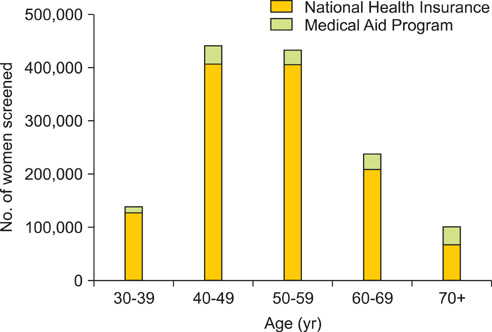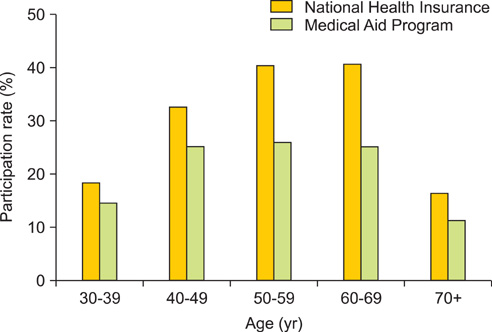Current status of the National Cancer Screening Program for cervical cancer in Korea, 2009
- Affiliations
-
- 1National Cancer Control Institute, National Cancer Center, Goyang, Korea. jkjun@ncc.re.kr
- 2Department of Social Medicine, Dankook University College of Medicine, Cheonan, Korea.
- KMID: 2177509
- DOI: http://doi.org/10.3802/jgo.2012.23.1.16
Abstract
OBJECTIVE
The National Cancer Screening Program (NCSP) began in 1999. In this report, we evaluate the results of the NCSP for cervical cancer in 2009 and provide participation rates in an organized cervical cancer screening program in Korea.
METHODS
Using data obtained from the National Cancer Screening Information System, cervical cancer screening participation rates were calculated. Recall rates, defined as the proportion of abnormal cases among women screened, were also estimated with 95% confidence intervals.
RESULTS
The target population of cervical cancer screening in 2009 included 4,577,200 Korean women aged 30 and over, 1,349,668 of whom underwent the Papanicolaou smear test (29.5% participation rate). Compared with the participation rate of women covered by the National Health Insurance Program (31.3%), the participation rate of women covered by the Medical Aid Program was lower (18.4%). Participation rates also varied in different age groups (the highest of 39.3% in women aged 50 to 59 and the lowest of 14.4% in those aged 70 and older), and different areas (the highest of 34.1% in Busan and the lowest of 21.5% in Chungnam). The overall recall rate for cervical cancer screening was 0.41% (95% confidence interval, 0.40 to 0.42).
CONCLUSION
According to our study, efforts to facilitate participation and reduce disparities in cervical cancer screening among Korean women are needed.
MeSH Terms
Figure
Cited by 3 articles
-
Trends in Cancer Screening Rates among Korean Men and Women: Results from the Korean National Cancer Screening Survey, 2004-2012
Mina Suh, Kui Son Choi, Yoon Young Lee, Jae Kwan Jun
Cancer Res Treat. 2013;45(2):86-94. doi: 10.4143/crt.2013.45.2.86.Trends in Cancer Screening Rates among Korean Men and Women: Results of the Korean National Cancer Screening Survey, 2004-2013
Mina Suh, Kui Son Choi, Boyoung Park, Yoon Young Lee, Jae Kwan Jun, Duk-Hyoung Lee, Yeol Kim
Cancer Res Treat. 2016;48(1):1-10. doi: 10.4143/crt.2014.204.Factors associated with cervical cancer screening behaviors among young married female (aged 20–29) immigrants in South Korea
Sae Mi Park, Joo Won Lee, Yunhee Lee, Jun-Pyo Myong, Ha Kyun Chang, Kyung-Jin Min, Nak Woo Lee
Obstet Gynecol Sci. 2023;66(1):26-33. doi: 10.5468/ogs.22008.
Reference
-
1. Parkin DM, Bray F, Ferlay J, Pisani P. Global cancer statistics, 2002. CA Cancer J Clin. 2005. 55:74–108.2. Jung KW, Park S, Kong HJ, Won YJ, Lee JY, Park EC, et al. Cancer statistics in Korea: incidence, mortality, survival, and prevalence in 2008. Cancer Res Treat. 2011. 43:1–11.3. Mun JY, Han MA, Lee HY, Jun JK, Choi KS, Park EC. Cervical cancer screening in Korea: report on the National Cancer Screening Programme in 2008. Asian Pac J Cancer Prev. 2011. (in press).4. Lee EH, Lee HY, Choi KS, Jun JK, Park EC, Lee JS. Trends in cancer screening rates among Korean men and women: results from the Korean National Cancer Screening Survey (KNCSS), 2004-2010. Cancer Res Treat. 2011. 43:141–147.5. Kim Y, Jun JK, Choi KS, Lee HY, Park EC. Overview of the National Cancer screening programme and the cancer screening status in Korea. Asian Pac J Cancer Prev. 2011. 12:725–730.6. Solomon D, Davey D, Kurman R, Moriarty A, O'Connor D, Prey M, et al. The 2001 Bethesda System: terminology for reporting results of cervical cytology. JAMA. 2002. 287:2114–2119.7. Benard VB, Eheman CR, Lawson HW, Blackman DK, Anderson C, Helsel W, et al. Cervical screening in the National Breast and Cervical Cancer Early Detection Program, 1995-2001. Obstet Gynecol. 2004. 103:564–571.8. Bastos J, Peleteiro B, Gouveia J, Coleman MP, Lunet N. The state of the art of cancer control in 30 European countries in 2008. Int J Cancer. 2010. 126:2700–2715.9. Anttila A, Ronco G, Clifford G, Bray F, Hakama M, Arbyn M, et al. Cervical cancer screening programmes and policies in 18 European countries. Br J Cancer. 2004. 91:935–941.10. Smith RA, Cokkinides V, Brooks D, Saslow D, Brawley OW. Cancer screening in the United States, 2010: a review of current American Cancer Society guidelines and issues in cancer screening. CA Cancer J Clin. 2010. 60:99–119.11. Benard VB, Saraiya MS, Soman A, Roland KB, Yabroff KR, Miller J. Cancer screening practices among physicians in the national breast and cervical cancer early detection program. J Womens Health (Larchmt). 2011. 20:1479–1484.12. The National Breast and Cervical Cancer Early Detection Program 1991-2002 national report. US Department of Health and Human Service. 2005. Atlanta: Centers for Disease Control and Prevention.13. NHS cervical screening England 2009-10 [Internet]. Health and Social Care Information Centre. 2010. cited 2011 Sep 15. Leeds: Health and Social Care Information Centre;Available from: http://www.ic.nhs.uk/webfiles/publications/008_Screening/cervscreen0910/2009_10_Cervical_Bulletin_Final_Report_AI_v1F.pdf.14. Health statistics in Japan 2010 [Internet]. Statistics and Information Department, Japan. 2011. cited 2011 Sep 15. Tokyo: Minister of Health, Labour and Welfare;Available from: http://www.mhlw.go.jp/toukei/saikin/hw/hoken/national/dl/22-00.pdf.15. Aklimunnessa K, Mori M, Khan MM, Sakauchi F, Kubo T, Fujino Y, et al. Effectiveness of cervical cancer screening over cervical cancer mortality among Japanese women. Jpn J Clin Oncol. 2006. 36:511–518.16. Jun JK, Choi KS, Jung KW, Lee HY, Gapstur SM, Park EC, et al. Effectiveness of an organized cervical cancer screening program in Korea: results from a cohort study. Int J Cancer. 2009. 124:188–193.17. Pettersson BF, Hellman K, Vaziri R, Andersson S, Hellstrom AC. Cervical cancer in the screening era: who fell victim in spite of successful screening programs? J Gynecol Oncol. 2011. 22:76–82.18. Shin HR, Park S, Hwang SY, Kim JE, Jung KW, Won YJ, et al. Trends in cervical cancer mortality in Korea 1993-2002: corrected mortality using national death certification data and national cancer incidence data. Int J Cancer. 2008. 122:393–397.19. Liu T, Wang X, Waterbor JW, Weiss HL, Soong SJ. Relationships between socioeconomic status and race-specific cervical cancer incidence in the United States, 1973-1992. J Health Care Poor Underserved. 1998. 9:420–432.20. Park MJ, Park EC, Choi KS, Jun JK, Lee HY. Sociodemographic gradients in breast and cervical cancer screening in Korea: the Korean National Cancer Screening Survey (KNCSS) 2005-2009. BMC Cancer. 2011. 11:257.21. Han CH, Cho HJ, Lee SJ, Bae JH, Bae SN, Namkoong SE, et al. The increasing frequency of cervical cancer in Korean women under 35. Cancer Res Treat. 2008. 40:1–5.22. Liu S, Semenciw R, Mao Y. Cervical cancer: the increasing incidence of adenocarcinoma and adenosquamous carcinoma in younger women. CMAJ. 2001. 164:1151–1152.23. National Institutes of Health Consensus Development Conference statement on cervical cancer, April 1-3, 1996. Gynecol Oncol. 1997. 66:351–361.
- Full Text Links
- Actions
-
Cited
- CITED
-
- Close
- Share
- Similar articles
-
- Current status of the National Cancer Screening Program for cervical cancer in Korea, 2009
- Current Status of Cancer Screening Rate and Epidemiologic Study for Evaluating the Effectiveness of Cancer Screening in Korea
- Current status of cervical cancer and HPV infection in Korea
- Research on Uterine Cervical Cancer in Korea: Current Status and Perspectives
- Evidence-based National Cancer Screening program of Korea




